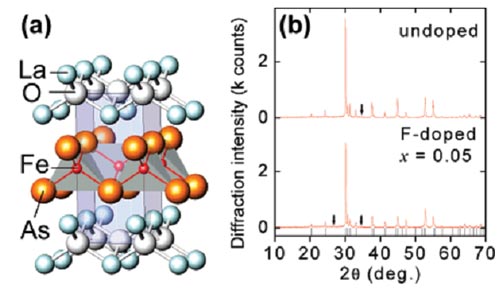High-temperature superconducting materials based on iron
For more than twenty years, physicists have been unable to accurately explain the phenomenon of high-temperature superconductors, which seem to occur only in special groups of compounds that are mostly based on copper (Cu) and how to happen And recently, scientists in Japan have discovered a completely new type of iron (Fe)-based high-temperature superconductor that allows physicists to learn more easily and clarify points. weighting on the mysterious phenomenon in this solid physics.
Superconductivity is the complete disappearance of the resistance of the material when cooled under a superconducting phase transition temperature (TC). Superconductivity is based on the creation of reciprocal pairs of electrons, through the formation of called pairs meeting Cooper to transfer in materials without obstruction (without resistance). This phenomenon is described in Bardeen-Cooper-Schrieffer (BCS) theory of low-temperature superconductivity, where Cooper pairs are made possible by linking electrons together through the exchange of phonons (field particles). of lattice vibrations).
However, the BCS theory cannot explain the properties of high-temperature superconductors, which have been discovered since 1986 (the highest current transition temperature value reaches 138 K), and compounds These are mostly compounds of copper (cuprates) containing parallel planes of copper oxide in which copper atoms are located on a square lattice and charge is carried by holes in the position of oxygen. Each copper atom will have an unpaired electron and therefore researchers believe that the magnetic (or spin) interconnected will create superconducting properties in these materials.

Figure 1. Crystal structure and X-ray diffraction spectrum of the material (J. Am. Chem. Soc. 130 3296).
Recently, Hideo Hosono and colleagues at Tokyo Institute of Technology (Japan) first discovered a high-temperature superconducting material with a transition temperature of 26 K based on iron-Fe compounds ( can see these results on J. Am. Chem. Soc. 130 3296). This is a compound LaOFeAs containing the layers of Lanthanum (La) Oxi (O) sandwiched by layers of Iron (Fe) and Arsenic (As) - and added fluoride ions . The researchers hope to increase the transition temperature by more than 26 K by altering the process of handling materials (eg pressure setting .). Preliminary studies of this material assume that superconductivity occurs in phonon-mediated non-intermediate materials as expected from classical BCS theory, but may not be similar. as predicted in ' cuprates ' high-temperature superconducting compounds.
'Someone might argue that superconductivity in these materials is a phonon intermediate in low-temperature superconductors,' - Kristjan Haule, a theoretical physicist at Rutgers University (USA) is doing. work in a group is also researching this material. ' However, we have made calculations using functional theory and assume that the TC is almost around 1 K if the phonons have that function.' Haule's team calculated that the non-doped LaOFeAs compounds have very poor metallic properties at low temperatures and are almost an insulator. Haule told Physicsworld.com: 'This is a strong evidence to say that superconductivity is not mediated by phonons, which requires a very good metallic state with coherent carriers'.

Figure 2. Changes in resistivity and magnetic susceptibility depend on the temperature of the material.Phase transition occurs at 26 K (J. Am. Chem. Soc. 130 3296).
Indeed, this poor metallic property is like mildly doped high-temperature superconductors - Haule explained further. According to Haule's team, this means that weak binding theories - for example the theory of spin fluctuations - that were previously hypothesized to describe cuprates would no longer be useful to explain superconductivity. in compounds LaOFeAs. And preliminary experimental results from Hosono's group are very consistent with these findings.
This new superconducting material is also a proof to prove that superconductivity is not limited by copper oxides and some other compounds based on Uranium (U), Cerium (Ce), Plutonium (Pu). Although superconductivity can be destroyed by high magnetic fields, the discovery has shown that it can even exist in strongly magnetic materials ( eg Iron when surrounded by atoms. appropriate, which in this case is As ). Furthermore, this effect is related to the trajectory of electrons, which are often neglected in cuprates, which may also play an important role. Haule believed that this new superconductor could be extremely important for technology, but much more research was needed before saying anything with certainty.
The Doctrine of Independence (According to Physicsworld.com & American Chemical Society, Vietnam Physics)
- Develop superconducting materials towards commercial applications
- Physicists find superconductors at new high temperatures
- Explain the mystery of the 30 years of origin of superconductivity
- Discovering new characteristics of superconductors can change the world
- Terahertz frequency generator (THz) uses high temperature superconducting materials.
- For the first time, it has successfully created superconductivity for ordinary materials
- Research on new generation superconducting materials
- Ancient people made iron from meteorites
- The future will have superconductors operating under room temperature conditions
- Invented the world's smallest superconducting material
- Create a super-elastic material that can generate electricity when pulled or compressed
- The development of materials
 Daily use inventions come from universities
Daily use inventions come from universities Special weight loss device helps prevent appetite
Special weight loss device helps prevent appetite 8 inventors were killed by their own inventions
8 inventors were killed by their own inventions Iran invented a motor car powered by water
Iran invented a motor car powered by water